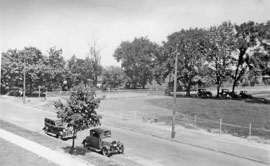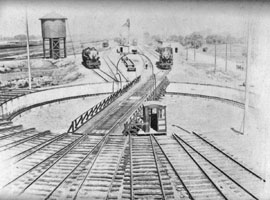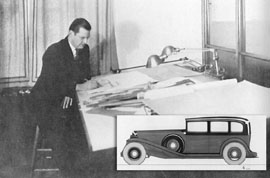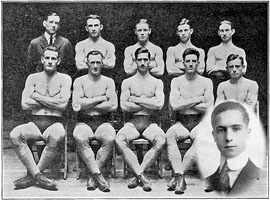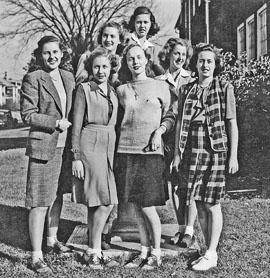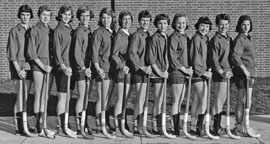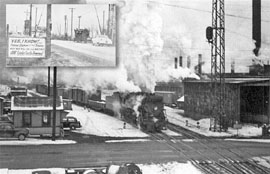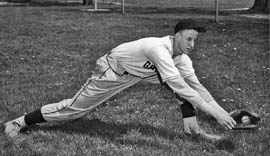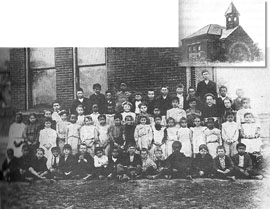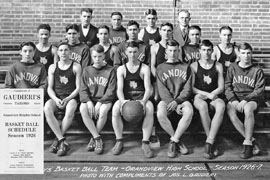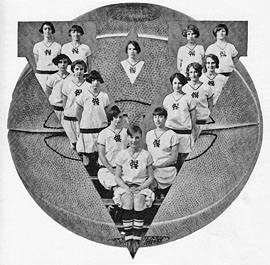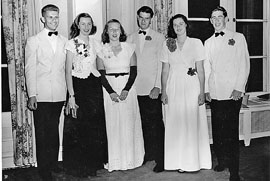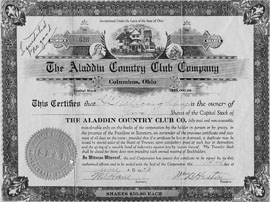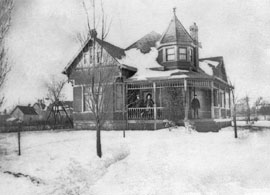| |
 |
| |
Studebaker
Police Cruisers |
|
The Studebaker car company of South Bend, Indiana introduced their Lark
compact model in 1959. It was a pioneering design with a small wheelbase,
minimal use of chrome, and simple lines. It bucked the conventional low,
wide, and long "finned" designs prevalent at the time. A properly tuned
Lark, with a V8 engine, could turn 0 to 60 mph in ten seconds, which might
explain their use as police vehicles. Shown in the background of the above
photo are three Grandview Heights Lark police cruisers. The cruisers appear
to be 1960 models. Studebaker ceased operations by 1966. The gentlemen
in the picture and the circumstances surrounding the photograph are not
known. |
|
| |
Third and
North Star |
|
This undated photograph is taken looking northwest from the Grandview
Heights High School, which was opened in the fall of 1923. It shows students
lounging at their cars parked near the site of the current concession stand
at the south end of the stadium at the intersection of Third and North
Star Avenues. At the time this photograph was taken there was no stadium,
no track, nor tennis courts (the stadium was built as a WPA Project and
dedicated in 1938.) Over the next ten years, whenever the opportunity arose,
the Board of Education methodically bought parcels of land north of the
school to accommodate the expanding sports programs. |
|
| |
Bob Fields |
|
his photograph was taken in 1923 at the northwest corner of Oakland and
First Avenues. GHHS graduate Bob Fields (back right, class of 1922) and
three unidentified friends sit in and on a Chevrolet roadster having a
cigarette break in the parking lot of the Red Crown gasoline station. The
station replaced the Hinterschied grocery and general store, which had
occupied this corner since 1896. The air pump at the station is visible
to the left behind the car. The former Celeste Building (originally Gutches
Grandview Market, and later Gaudieri's Cleaners and Tailor Shop), visible
at the right, was razed to build the four condominiums presently occupying
the northeast corner of the intersection. The 1923 yearbook alumni updates
indicated that Bob attended "office training school after graduation and
was a full-fledged businessman" and planned to enter OSU in the fall of
1924. |
|
| |
C.V. Money |
|
C. V. ("Red") Money was hired (with considerable fanfare) as the GHHS
athletic director in 1925, remaining in the district for only two years.
His nickname was derived from the color of his hair. He coached all the
boys' team sports but basketball was his forte. During his short tenure
his accomplishments were legend. His Bobcat teams played a total of 43
games and won all but 9 of them, and his 1926 basketball team won the Franklin
County championship. It was also during his tenure that the Varsity "G"
club, which he founded, formally adopted the bobcat as the school mascot.
He left Grandview to coach at Hanover College and took Ralph Anderson and
Don Frantz, two GHHS star athletes, with him. The Historical Society is
indebted to his son Robert for recently donating an amazing selection of
GHHS sports memorabilia to our collection. |
|
| |
High School
Plans |
|
The first and second floor plans for the Grandview High School were included
in the school's first student handbook, THE BLUE BOOK, published in 1926
by the student council for the benefit of incoming students. It is evident
from the plans that eighty-two years ago a larger percentage of classroom
space was devoted to domestic science, mechanical drawing, commercial typing,
shop, and other courses designed for students to enter the work force after
receiving their diploma. Sixteen credits were required for graduation,
including the only required courses of physical science, English, American
History, and physical education. The dual-purpose gym and auditorium with
removable seats was state of the art. |
|
| |
Grandview
Fire Department |
|
This photograph, taken in July 1941, shows Grandview's 1924 Seagrave
fire engine at the rear of the municipal building. The firefighters shown
are, left to right, Roy McCollister, Fred Musser, and Frank Turner. The "medium
weight" fire truck and the station to house it were part of a 1923
bond issue that was proposed by Mayor Ryder after a financial dispute with
the City of Columbus, who had discontinued fire service to Grandview and
Marble Cliff. This photo shows the building after the new bay on the right
(with the additional two dormers) was added in 1936. |
|
| |
Trinity United
Methodist |
|
This 1950 photo shows the construction of the steeple on the Trinity
United Methodist Church at 1581 Cambridge, which was opened in 1951. The
Church held meetings starting in 1891 in a frame building in a new subdivision
at the corner of Fifth and North Star. They later moved their services
to the new Harding School on Fairview, while they built a building in 1894
at 1529 North Star. As the membership grew, the Church built a new building
across the street at the corner of W. Fifth and North Star in 1902, followed
by a building at W. First and Ashland in 1915. The 1951 building was expanded
in 1956 and again in 1992. |
|
| |
Long's Drugs |
|
Long's Drugs was located in the Grandview Bank Block at 1275 Grandview
Avenue, at the current site of Stauf's Coffee. This 1947 photograph shows
a group of Grandview Heights High School students near the front entrance
of the local hangout. The drug store had a pharmacy, sandwiches, and a
popular ice cream and soda fountain. The facade of the store was removed,
and part of the store was eliminated to make way for the breezeway between
the front and the back parking area. |
|
| |
Grandview Yard |
|
This turn of the century photo shows the Grandview Yard of the Pennsylvania
Railroad, which was on the Piqua line of what was known as the PRR "Panhandle" route.
The Piqua line ran from Union Station through Grandview, "Hilliards",
Plain City, and Urbana to Piqua. The yard, which was a switch yard (or
hump yard) was located south of Goodale Avenue between Grandview Avenue
and the Olentangy River. The yard could handle over 660 cars, and was used
for interchanging coal cars from the C&O destined for the Sandusky
Branch of the PRR or the Chicago route on the Piqua line. It was also used
as an overflow yard for PRR Yard A (south of 20th between St. Clair and
Taylor Avenues on the east side of Columbus) and Yard B (near Ft. Hayes).
In addition the yard was used to reroute stone cars from the Marble Cliff
Quarry. |
|
| |
Alan Leamy |
|
Alan H. Leamy was born in Maryland in 1902, and moved to Grandview in
1905 when his father assumed the position of District Manager of the Welsbach
Co. which manufactured gas mantels. Alan was fascinated with automobile
designs, and at the age of 25 became a stylist for the Marmon Motor Co.
in Indianapolis. He later became the chief stylist for Cord/Duesenberg,
designing America's first front wheel drive car, the 1929 Cord L-29. Three
of his trademark designs, the graceful radiator shell, the artistic hood
and the sweeping clamshell fender extending into the running board, were
evident in the design of the famous Duesenberg Model J, the 1931 Auburn
8-98, and the LaSalle and Cadillac (inset), designed just before Leamy
became the chief stylist at the LaSalle division of GM in 1934. Leamy died
at age 33 of septicemia from a medical procedure. |
|
| |
Jasper Mead |
|
The May 1921 edition of The Norwester, the Tri-Village community magazine,
featured Jasper "Jap" Mead and his home at 1581 West First Avenue.
Jasper spent his entire career working for the Columbus Dispatch, starting
in the mailroom and advancing to the head of the advertising department.
He and his wife Olive and their children Maxine, Phyllis, and Bobbie are
presumed to have been the first residents of this home. Their residence
still exists, however due to postal reconfiguration that took place all
over Grandview Heights in 1928, the current address is 1463 West First
Avenue, just east of the intersection of Grandview and First Avenues. |
|
| |
Perry Martter |
|
Perry Martter was one of thirteen graduates in the GHHS class of 1918.
He was a solid academician and played football. His senior yearbook picture
is on the lower right. He enrolled in The Ohio State University where he
excelled academically as an engineering student and distinguished himself
as a member of the wrestling team. He was the team captain at OSU and won
the Western Conference welterweight championship for two years. Martter
is in the front row center of the OSU wrestling team photo (above) from
the 1923 issue of The Ohio State Engineer magazine. He was selected as
a member of the 1924 U.S. Olympic team during in Paris, France. The team
was composed of 14 members and he was one of 2 wrestlers in his division.
After graduation Perry moved to Los Angeles where he joined his father
in the construction business. He died in 1954 at the age of 53. |
|
| |
Gas Ration Volunteers |
|
These GHHS senior girls were photographed after volunteering to process
gas ration booklets during WWII, and were featured in the September 19,
1944 edition of the Columbus Dispatch. Pictured are (front left to right)
Peggy Gammill, Shirley Close, Angela McGrath, and Pat Donovan, and (back)
Shirley Ann Arthur, Judy Cash, and Ann Devlin. Unbeknownst to these students
the picture and their home addresses were also published in the Columbus
Dispatch Service Edition, which was mailed to combat troops from Franklin
County. All of the young women received a deluge of letters from soldiers,
sailors, and marines from all over the world. None of the letters reportedly
contained any marriage proposals. However, Judy Cash received the official
title of "Dream Girl of the 163rd Company", a company of seamen from the
Great Lakes Naval Training Center in Illinois. |
|
| |
Girl's Field Hockey |
|
This photograph shows what the Historical Society presumes is the 1958
Girls Athletic Association Varsity B field hockey team (the 1958 Highlander
only pictures the Varsity A team.) Field hockey was featured for the first
time in the 1932 Highlander and appears to have been a girls' intramural
activity, eventually becoming a varsity team sport. Generations of GHHS
girls participated in the game, but the 2001 academic year appears to have
been the final season due to declining interest and the evolution of soccer
as a girls' sport in Grandview. The identities of the team members are
not known. If anyone can identify any players in this photograph please
contact the GHMCHS at tdemaria@columbus.rr.com |
|
| |
West Yard |
|
The Moment in Time in the September 24th issue of ThisWeek featured the
Grandview Yard switching facility, but the photograph was of the Columbus
West Yard. The GHMCHS apologizes for the error. The Toledo & Ohio Central
Rail Road operated the West Yard switchyard for re-routing train cars near
the intersection of Grandview and McKinley Avenues, located north of McKinley
between Glenwood and Grandview Avenues. The C.O.T.A. Bus garage now occupies
the site where the West Yard was located. Switch engines were used to move
the train cars and constantly snarled local traffic along Grandview Avenue.
This newspaper photograph (inset) from 1952 shows how a gasoline station
near the tracks attempted to take advantage of the situation by sympathetically
and cleverly suggesting that motorists fill up their tanks while they waited
for the trains. |
|
| |
Ed Smith |
|
The late Ed Smith was a 1947 graduate of GHHS and a star scholar-athlete.
During his four-year high school career he won seven athletic awards, three
in baseball and two each in basketball and football. He was all-CBL in
basketball his senior year and achieved a league scoring record of 32 points.
Ed was accepted at Harvard where he played basketball for the Harvard Crimson
and was captain of the team during the 1950-1951 season. He was selected
by the New York Knicks in the first round (6th pick overall) during the
1951 NBA Draft. He played for the Knicks through the 1954 season. |
|
| |
First and Oakland |
|
This photograph is from the "Howdy Neighbor" section of an unidentified
1942 Columbus newspaper. A montage of photographs showed the busy intersection
of First and Oakland Avenues looking east. Sohio and Shell gas stations
were diagonally across from one another. The building on the northeast
corner was the former Celeste Building that was razed to build the condominiums
along the east side of Oakland Avenue. McKinley Drug Store at 1655 West
First occupied the southwest corner. The Tremaine Electric Shop was next
door at 1657 West First. The commercial buildings west of the intersection
and south of First Avenue were razed over time to accommodate the expansion
of the Grandview Heights Public Library. This particular photograph is
from the Joyce Jones Alibrando collection. |
|
| |
Polkadot School |
|
This circa 1900 photograph shows students from the "Polkadot School"
standing outside their one room schoolhouse. The school (inset) was located
on the west side of Virginia Avenue near Chambers Road and got its name
from the fact that it was equally integrated. It served the residents of
Sellsville, an unincorporated community bordered by the King and Fifth
Avenues (north and south) and the Olentangy River and Virginia Avenue (east
and west). It was a vibrant, racially mixed community comprised of blacksmith
shops, saloons, truck farms, slaughterhouses, and most notably the winter
home of the Sells Brothers' Circus. These photographs are from the 1971
book, Sellsville Circa 1900, written by Carl Weisheimer. It is a rich,
detailed compilation of the early history of the community. The names of
all the students in the photograph are listed in the book. |
|
| |
Sledding on Stone Hill |
|
A headline in the 1928 edition of the Community Newspaper stated that
Grandview Heights claimed to be the sledding center of central Ohio. One
of the best places for sledding was the hill fronting the Julius Stone
mansion at the intersection of Westwood Avenue and Goodale Boulevard. The
above photograph from 1945 shows GHHS students about to descend the hill
on a sled with wooden runners. The Stone mansion (background) was razed
and the four-acre estate was developed as Stonegate Village. Two homes
currently occupy the site of the original mansion. The smiles on the teenagers
do not reveal just how dangerous this winter pastime could be. Injuries
were frequent and Clarence P. Lauderbaugh, a member of the GHHS class of
1938, died as a result of a sledding accident on this favorite sledding
hill. This photograph is from the collection of the late Joyce Jones Alibrando,
GHHS class of 1946. |
|
| |
Urlin Mansion |
|
A cow relaxes in the field near Goodale Blvd. and Urlin Avenue. The house
on the hill was the home of George Urlin, which was located on the site
of Summit Chase, which currently stands on the hill. The field (donated
by the Urlins to the city) is now the tennis courts and ball diamond at
Mckinley Park. Mr. Urlin and several other early pioneers purchased the
land on the bluff above what would become Goodale Boulevard with the intent
of establishing a small community. Mr. Urlin was instrumental in the founding
of Grandview Heights, as he and his colleagues laid out the plans for what
would ultimately become the city. George initially owned a well-known photography
studio in downtown Columbus, later branching out into real estate with
his Suburban Real Estate Company. He and his wife also donated the property
on which the Grandview Library was built, and for the house which was built
by the high school fraternity Brotherhood of the Rook. |
|
| |
1926-27 Boys Basketball |
|
The 1926-1927 GHHS boys' basketball team is shown in the above photograph.
The season was somewhat of a disappointment since the team hoped to defend
their Franklin County Boys' Basketball Championship title. Unfortunately,
only three members of the squad were from the previous year's championship
team, and the team only won the first and last games they played that year.
Through it all, the basketball team was enthusiastically supported by Joseph
L.Gaudieri, of Gaudieri's Tailors. His shop was on the northeast corner
of First and Oakland Avenues. He paid for this group photograph that was
distributed to the boys at their annual banquet at the Arlington Country
Club. Gaudieri also underwrote the cost of printing the basketball schedules
(see inset). The team photo and schedule are from a collection of sports
memorabilia recently donated by descendants of the team's coach, C.V. "Red"
Money. He is pictured in the back row on the far left. |
|
| |
Salzgeber Coal
Co. |
|
The Salzgaber family played an important role in the settlement and expansion
of the Grandview Heights and Marble Cliff area. The family owned a farm
on land which is located at First and Grandview Avenue, which they sold
to developers for the expansion of Grandview to the east. They moved their
truck farming business to Lane Avenue, across from what is now the Lane
Avenue Shopping Center. A different spelling of the name is seen here on
this truck in a 1920 photo, taken in front of the Salzgaber home at 1237
Grandview Avenue. The Salzgeber Coal company was located off of Fifth Avenue
in what became known as Sellsville, the winter quarters of the Sells Bros.
Circus. |
|
| |
1927 Girls' Basketball |
|
The GHHS 1927 girls' basketball team, unlike the boys' team featured
in this column two weeks ago, enjoyed an undefeated 1926-1927 season. They
were recognized as a "powerhouse" by the local press. They were also champions
in the 1922-1924 seasons. This photograph from a feature article in the
local press shows the team appropriately arranged in a "V" for victory.
Margot Younger, the team captain, is in the diamond in the center. The
team was coached by Emily Peterson. They defeated St. Mary's, Upper Arlington,
Westerville, Munk Florals, Marysville, New Albany, Ohio State School for
the Deaf, Canal Winchester, and Bexley. Bexley was by far their fiercest
rival. The location of Munk Florals is not known. |
|
| |
Larry Larson |
|
Larry Larson was finishing his first year as the GHHS athletic director
when this photograph was taken for the 1979 Highlander. He joined the school
district in 1966 and served in many capacities, including head football
coach from 1976 to 1982. A living legend, Larry continues to impact the
children of the community since he retired. He directs the 5th and 6th
grade camp programs and recently starred in the Edison Elementary students'
video project entitled Grandview 101. In addition to his signature bow
tie, Larry is also well recognized for his boundless energy and his amazing
capacity for remembering the names of his former students and their parents.
"Mr. High School Sports" was recently the subject of an article by Michael
Arace in the December 21, 2008 Columbus Dispatch. It is a tribute well
worth reading. |
|
| |
L.A.L. Sorority |
|
This photograph shows GHHS L.A.L. Sorority sisters and their dates at
the L.A.L. Commencement Formal on June 4, 1946. They are identified (from
l to r) as: Gene Garner, Ann Gebhardt, Jinny Titus, Al Hunt, Joyce Jones,
and Bill Merrick. The photograph is from the Joyce Jones Alibrando collection.
An admission ticket that Joyce saved indicates that the formal started
at 10:00PM and ended at 1:00AM and was held at the Columbus Country Club
with music provided by Don Crawford's Orchestra. The cost was $2.00 couple
or $1.00 stag. L.A.L. was one of two sororities at Grandview High School.
It was founded in 1922 and lasted until 1960 when state law prohibited
high school fraternities and sororities. |
|
| |
Aladdin Stock Certificate |
|
Arlington Country Club was developed on 150 acres on the western edge
of Marble Cliff in 1895. It was the social center of the suburb until 1919,
when it was sold to the Shriners for exclusive use of its members. They
renamed it the Aladdin Country Club. Shares of stock were sold to raise
the $50,000 needed to finance the purchase of the golf course and clubhouse.
This stock certificate for two shares at $50 each was purchased by Horace
Willoughby, who was one of the principal owners of Ross-Willoughby Co.
and who lived at 1143 Westwood in Grandview. |
|
| |
Newhouse, Winter
view |
|
Members of the Clinton Newhouse family gather on the front porch
of their new home at 2020 West Third Avenue after a winter storm around
1900. Their home was one of the first in the Arlington Place subdivision
that would eventually evolve into present day Marble Cliff. At the time
there were no paved streets or electrical lines leading to the home.
Mr. Newhouse was Station Master at Marble Cliff Rail Road Station. Except
for a small kitchen addition and cosmetic changes this historic home
still stands at the northwest corner of the Arlington and Third Avenues. |
|

